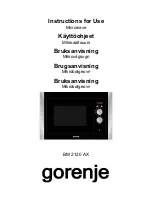
17
Causes of damage
NOTICES:
▯
Metal
e.g. a spoon in a glass
must be kept at
least 1" (25 mm) from the oven walls and the
inside of the door. Sparks could irreparably
damage the glass on the inside of the door.
▯
Water in the hot oven interior: Never pour water
into the hot oven interior. Steam is produced.
Damage to the enamel can arise due to the
temperature change.
▯
Do not leave moist groceries in a closed oven for
an extended period of time. It can lead to
corrosion inside the oven.
▯
Fruit juice can leave stains in the oven. Always
remove fruit juice immediately and wipe up first
with a damp and then a dry cloth.
▯
Cooling with the appliance door open: only allow
the oven cavity to cool when it is closed. Even if
the appliance door is only open a little, front
panels of adjacent units could be damaged over
time.
▯
Highly soiled door seal: the appliance door will no
longer close properly during operation if the door
seal is highly soiled. Adjoining furniture fronts
may be damaged. Always keep the door seal
clean.
▯
Appliance door as a seat or storage surface: do
not stand, sit or hang on the appliance door. Do
not place any cookware or accessories on the
appliance door.
▯
Inserting accessories: depending on the
appliance type, accessories can scratch the door
pane when closing the appliance door. Always
slide accessories fully into the oven interior.
▯
Do not hold or carry the appliance by the door
handle. The door handle cannot carry the weight
of the device and could break off, or the hinges
can be damaged.
▯
Operating the microwave without food in the oven
cavity may lead to overloading. Never run the
microwave unless there is food in the oven cavity.
An exception to this rule is a short ovenware test
(see the section
Microwave suitable ovenware
)
▯
Always set the microwave power as recommended
for the food. High power settings can overheat
foods very quickly.
Protecting the environment
Unpack the appliance and dispose of the packaging in
line with environmental requirements.
Tips for saving energy
▯
Only preheat the oven if this is specified in the
recipe or in the operating instruction tables.
▯
Use dark, black lacquered or enameled baking
tins for baking. They absorb the heat particularly
well.
▯
It is best to bake more than one cake, one after
the other. The oven is still warm. This reduces the
baking time for the second cake.
▯
For longer cooking times, you can switch the oven
off 10 minutes before the end of the cooking time
and use the residual heat to finish cooking.
















































